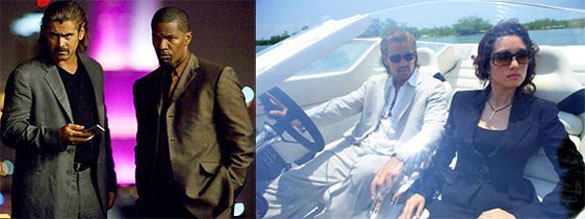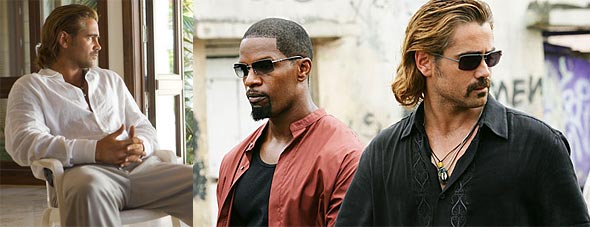
After watching two hours of fast cars, fast boats, and dead drug dealers, I must say I’m forced to raise the question: Can Miami Vice define the style of a new generation?
Miami Vice was written and directed by Michael Mann, and is based on the television series created by Anthony Yerkovich in the 1980s. The show ran five seasons, from 1984 to 1989, yet its influence on pop culture can still be felt almost two decades later in numerous areas —most notably, in fashion.
The series created a movement in men’s fashion with its impeccable white suits, pastel t-shirts worn underneath (a look that until this point was reserved for either the race track at Hialeah or the unemployment office) and sock-less loafers.
Looking back it’s easy to see how Gianni Versace, who worked as costume designer on the series, was a key influence in shaping the trend. Gianfranco Ferré and Giorgio Armani also contributed to the original Miami Vice look. With such style-power at work behind the scenes, it’s no wonder Miami Vice circa 1984 was such an epiphany of male fashion.
Jim Moore, creative Director of GQ magazine, readily admits that fashion of the Miami Vice series influenced everything they did at the time.
And any show that could turn three-day stubble into a 1980s fashion statement was bound to experiment with it in the 2006 version. Colin Farrell donned a modern version of the mullet and handlebar moustache, while Jamie Foxx’s neatly groomed facial hair was disturbingly reminiscent of Fu Manchu.

But that’s where the similarities end. All traces of color are gone from the cops’ attire, now replaced with black t-shirts and denim. The new version is darker, grittier and set in the decidedly unfashionable present, so it’s safe to say, unfortunately, that the theater version of Miami Vice isn’t going to spark any new trends.
There were mixed reviews about the fashion choices from audiences around the country. Tiffany Cozza of Philadelphia doesn’t seem to mind, “The updated fashion works. Using fashions from the ’80s would have disrupted the flow of the movie.” While Los Angeles native Matt Meyerson disagrees, “As a childhood fan of the show, the whole appeal of seeing the film was to see how they pulled off the shoulder pads and pastels in a modern context. I truthfully wanted to see if they could resurrect that ridiculous trend amongst the fashionistas, glitterati and wannabes. It was a total disappointment.”
In Miami Beach, it seems that the onscreen fashion is just a mirror of reality. Mike Wilson, who has lived in South Beach since the early ’80s says, “What you see – and saw back then – on screen is very true to what men here are wearing in real life. Instead of a lime green shirt under a white jacket, today men in Miami are more than likely sporting a linen guaybera shirt or a plain t-shirt – just like in the movie.”
In the ’80s version of Miami Vice, men sporting open shirts with a large gold medallion nestled in wild chest hair was de rigueur. Thankfully this and other stylistic nods to the era, were omitted – though Ferrell does successfully pull off the charm-on-leather-cord look in the movie.
Two decades ago, the creative story lines of Miami Vice brought big-screen excitement to television with style upstaging substance at every turn. But in the 2006 movie version, Mann’s directing and use of high definition technology are the true stars.
Casey Gillespie is the Managing Editor of Zink Magazine,
a fashion and lifestyle publication in New York.
